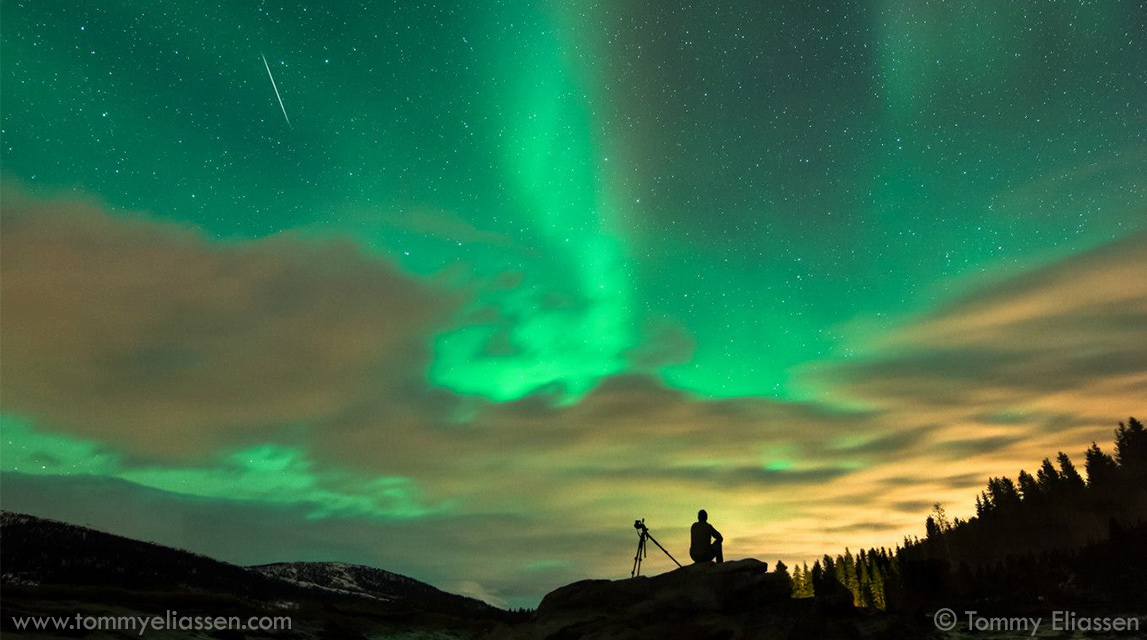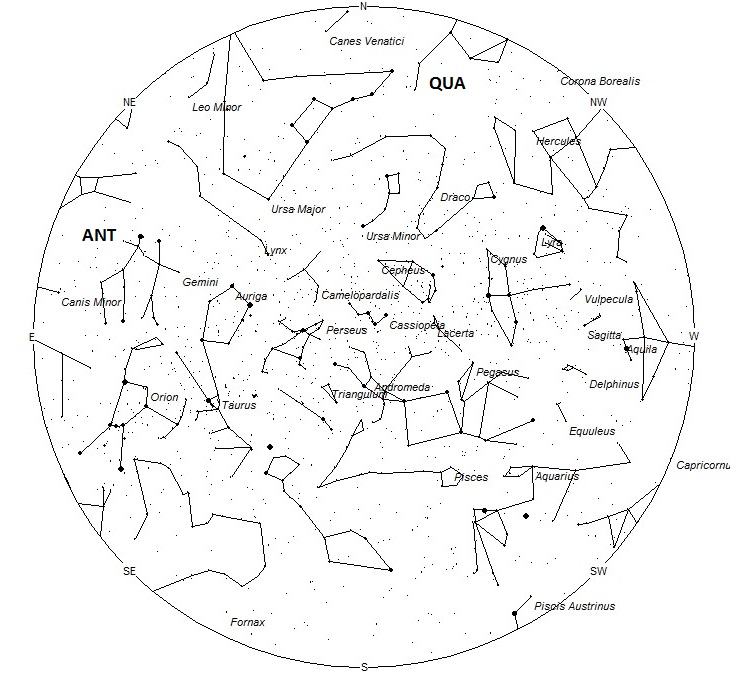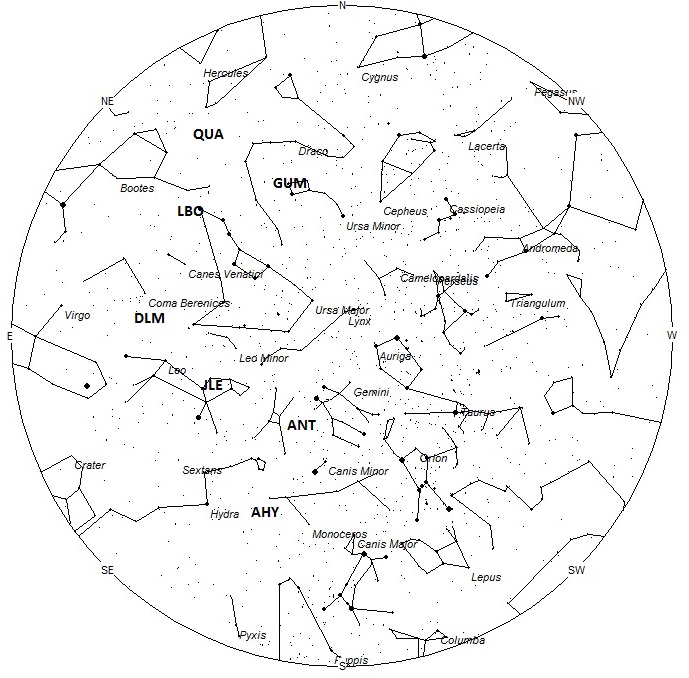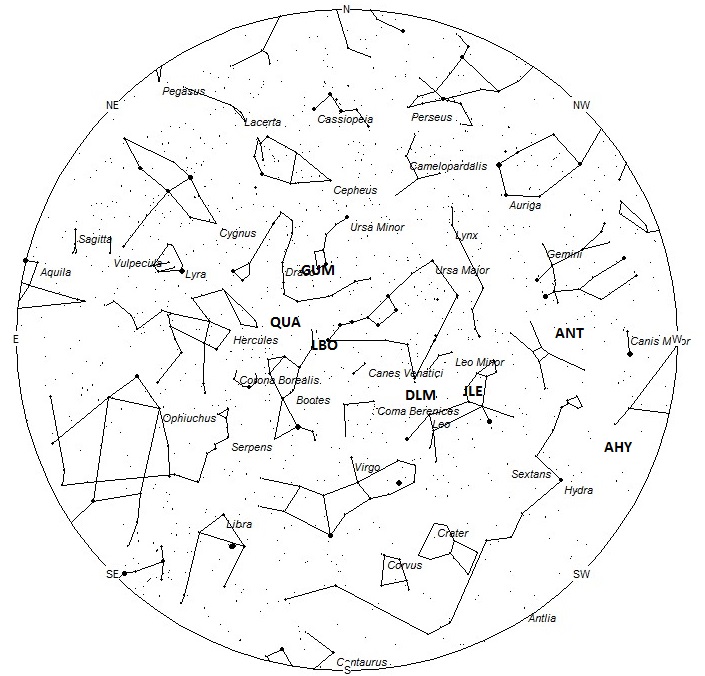
During this period the moon will reach its last quarter phase on Monday January 8th. At that time the half-illuminated moon will lie 90 degrees west of the sun and will rise near midnight local standard time (LST) as seen from mid-northern latitudes. This weekend the bright gibbous moon will lie in the sky from about 2200 LST onward. This is make viewing meteor activity difficult as the bright moon will obscure all bu the brighter meteors. As the moon passes last quarter on Tuesday, conditions improve with each passing night. The moon’s phase will shrink each night plus the moon will rise later and later. The estimated total hourly meteor rates for evening observers this week is near 4 as seen from mid-northern latitudes (45N) and 3 as seen from tropical southern locations (25S). For morning observers the estimated total hourly rates should be near 9 as seen from mid-northern latitudes and 8 from the southern tropics. The morning rates during this period are reduced due to moonlight. The actual rates will also depend on factors such as personal light and motion perception, local weather conditions, alertness and experience in watching meteor activity. Note that the hourly rates listed below are estimates as viewed from dark sky sites away from urban light sources. Observers viewing from urban areas will see less activity as only the brighter meteors will be visible from such locations.
The radiant (the area of the sky where meteors appear to shoot from) positions and rates listed below are exact for Saturday night/Sunday morning January 6/7. These positions do not change greatly day to day so the listed coordinates may be used during this entire period. Most star atlases (available at science stores and planetariums) will provide maps with grid lines of the celestial coordinates so that you may find out exactly where these positions are located in the sky. A planisphere or computer planetarium program is also useful in showing the sky at any time of night on any date of the year. Activity from each radiant is best seen when it is positioned highest in the sky, either due north or south along the meridian, depending on your latitude. It must be remembered that meteor activity is rarely seen at the radiant position. Rather they shoot outwards from the radiant so it is best to center your field of view so that the radiant lies near the edge and not the center. Viewing there will allow you to easily trace the path of each meteor back to the radiant (if it is a shower member) or in another direction if it is a sporadic. Meteor activity is not seen from radiants that are located far below the horizon. The positions below are listed in a west to east manner in order of right ascension (celestial longitude). The positions listed first are located further west therefore are accessible earlier in the night while those listed further down the list rise later in the night.
These sources of meteoric activity are expected to be active this week.
.
The center of the large Anthelion (ANT) radiant is currently located at 07:56 (119) +21. This position lies on the Gemini/Cancer border, 8 degrees southeast of the 1st magnitude star known as Pollux (beta Geminorum). Due to the large size of this radiant, Anthelion activity may also appear from Cancer, western Hydra, and Canis Minor as well as eastern Gemini. This radiant is best placed near 0100 local standard time (LST), when it lies on the meridian and is located highest in the sky. Rates at this time should be near 2 per hour as seen from the northern hemisphere and 1 per hour from south of the equator. With an entry velocity of 30 km/sec., the average Anthelion meteor would be of slow velocity.
The alpha Hydrids (AHY) are activie from a radiant located at 08:40 (130) -09. This area of the sky lies about 10 degrees west of the 2nd magnitude star Alphard (alpha Hydrae). These meteors are best seen near 02:00 LST when the radiant lies highest above the horizon. Rates should be near 1 per hour no matter your location. These meteors encounter the atmosphere at 43 km/sec., which would produce meteors of average velocity.
The last of the January Leonids (JLE) are expected this weekend. The radiant lies near 10:08 (152) +23. This area of the sky lies in western Leo, 2 degrees west of the 3rd magnitude star known as Adhafera (zeta Leonis). This area of the sky is best placed for viewing near 03:00, when it lies highest above the horizon. Current rates should be less than 1 per hour no matter your location. At 51 km/sec. the January Leonids produce mostly medium-swift meteors.
The December Leonis Minorids (DLM) are active from a radiant located at 11:40 (175) +23. This position lies in northeastern Leo, 9 degrees north of the 2nd magnitude star known as Denebola (beta Leonis). These meteors are best seen near 0400 LST when the radiant lies highest above the horizon. This shower peaked on December 20th so current rates would be less than 1 per hour no matter your location. At 63 km/sec. the December Leonis Minorids produce mostly swift meteors.
The lambda Bootids (LBO) were discovered by Dr. Peter Brown and his team at the University of Western Ontario, London, Ontario, Canada. They were using radio means to discover new streams. These meteors are active from December 31 through January 17 with maximum activity occurring on the 16th. The radiant currently lies at 14:08 (212) +49. This position lies on the border of Bootes and Ursa Major, 3 degrees east of the 2nd magnitude star known as Alkaid (eta Ursae Majoris). Current rates are expected to be less than 1 per hour. At 41 km/sec. these meteors are of medium velocity.
The gamma Ursae Minorids (GUM) were discovered also discovered by Dr. Peter Brown and associates. These meteors are active from January 09-20, with maximum occurring on the 18th. The radiant is currently located at 15:08 (227) +72, which places it southern Ursa Minor, just southwest of the 3rd magnitude star known as Pherkad (gamma Ursae Minoris). These meteors are best seen during the last few hours before dawn, when the radiant lies highest in a dark sky. Expected rates are less than 1 per hour during this period no matter your location. These meteors encounter the atmosphere at 30 km/sec., which would produce meteors of medium-slow velocity.
The Quadrantids (QUA) peaked on January 3/4 and now only a few remnants are left to be seen . The radiant is currently located at 15:32 (233) +49. This position lies in a blank area of northern Bootes, 10 degrees north of the 3rd magnitude star known as Nekkar (beta Bootis). Since we are well past maximum activity, current rates are less than 1 per hour. These meteors are best seen during the last hour before dawn when the radiant lies highest above the horizon in a dark sky. At 41 km/sec. the Quadrantids produce meteors of moderate velocity. These meteors are visible from the southern tropics but not seen from the deep southern hemisphere.
As seen from the mid-northern hemisphere (45N) one would expect to see approximately 6 sporadic meteors per hour during the last hour before dawn as seen from rural observing sites. Evening rates would be near 3 per hour. As seen from the tropical southern latitudes (25S), morning rates would be near 5 per hour as seen from rural observing sites and 2 per hour during the evening hours. Locations between these two extremes would see activity between the listed figures.
| SHOWER | DATE OF MAXIMUM ACTIVITY | CELESTIAL POSITION | ENTRY VELOCITY | CULMINATION | HOURLY RATE | CLASS |
| RA (RA in Deg.) DEC | Km/Sec | Local Standard Time | North-South | |||
| Anthelion (ANT) | – | 07:28 (112) +22 | 30 | 01:00 | 2 – 1 | II |
| alpha Hydrids (AHY) | Jan 03 | 08:40 (130) -09 | 43 | 02:00 | 1 -1 | IV |
| January Leonids (JLE) | Jan 03 | 10:08 (152) +23 | 51 | 03:00 | <1 – <1 | IV |
| December Leonis Minorids (DLM) | Dec 21 | 11:40 (175) +23 | 63 | 04:00 | <1 – <1 | II |
| lambda Bootids (LBO) | Jan 16 | 14:08 (212) +49 | 41 | 07:00 | <1 – <1 | I |
| gamma Ursae Minorids (GUM) | Jan 18 | 15:08 (227) +72 | 30 | 08:00 | <1 – <1 | II |
| Quadrantids (QUA) | Jan 03 | 15:32 (233) +49 | 41 | 08:00 | <1 – <1 | I |







 You saw something bright and fast? Like a huge shooting star? Report it: it may be a fireball.
You saw something bright and fast? Like a huge shooting star? Report it: it may be a fireball.  You counted meteors last night? Share your results with us!
You counted meteors last night? Share your results with us!  You took a photo of a meteor or fireball? You have a screenshot of your cam? Share it with us!
You took a photo of a meteor or fireball? You have a screenshot of your cam? Share it with us!  You caught a meteor or fireball on video? Share your video with us!
You caught a meteor or fireball on video? Share your video with us!